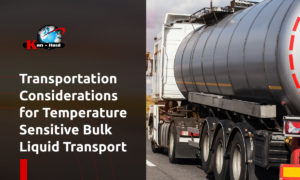May 7, 2020
Transportation Considerations For Temperature Sensitive Bulk Liquid Transport

Kan-Haul, a company that has performed temperature controlled shipping for more than 30 years, invites those in the transportation industry and other concerned parties to read the following brief blog discussing the considerations shipping entities must consider when planning the logistics of transferring temperature sensitive liquids.
Examples Of Temperature Sensitive Liquids
Liquids that can be influenced by temperature can vary. Simple items like milk and other dairy-based liquids can quickly spoil if not maintained at cooler temperatures. On the other end of the spectrum are flammable substances like gasoline, which if overheated might increase its combustibility and increase the chances for fires and explosions.
Important Bulk Liquid Transport Considerations
Prior to initiating a temperature controlled transport, the producers of the liquid in question and the entity responsible for shipping said product must consider several crucial factors, including:
The Product Type
As previously stated, certain liquids might be susceptible to significant adverse impacts if exposed to discernible for temperature fluctuations. Ergo, the volatility of the product in question should be at the top of any shipping entity’s list of concerns. All involved parties must educate themselves on how any type of temperature extreme can impact these liquids and even develop contingency strategies in the event unforeseen circumstances make such events unavoidable.
The Trip’s Duration
Certain liquids might be able to be transported safely at elevated or diminished temperatures for specific durations. However, during especially long trips, specific precautions may need to be taken. Ergo, travel time must be considered.
The Weather
Planning a controlled temperature transport is often contingent upon weather conditions at the departure site, along the entire route, and at the intended destination. Temperature fluctuations at any point might influence important decisions, such as the type of vehicle used in the transport and if any other safety or quality-preserving equipment will be needed.
The Loading And Unloading Processes
Transportation of temperature sensitive liquids does not begin and end with the trip. Proper precautions must be adhered to during the loading process and upon arrival. This means that the conditions during these processes must also be carefully monitored.
Commonly Employed Temperature Controlled Transport Vehicles
Cold Liquid Transports
Products that might be transported in colder conditions are shipped using refrigerated trucks. That said, these specialized vehicles are not like standard transportation trucks. One reason for this is a significant amount of their space is devoted to insulated walls designed to prevent cold air from escaping. Additionally, refrigeration equipment is weighty, which will more than likely decrease the vehicle’s payload capacity.
The storage of products necessitating colder transports should also be augmented by cooling products like dry ice or coolant gel. That said, if shipping by plane, dry ice presents more of a challenge due to regulations governing its usage. Additionally, these liquids should also be packed in protective coverings like paper toweling or cellulose waddling, which can absorb any runoff moisture.
Liquids Necessitating Warm Transports
Certain products must be kept well-heated throughout the transportation process. Such materials are typically transferred using:
Bulk Liquid Tankers
Many of these vehicles possess are equipped with steam-generating coil lines surrounding the tanker’s walls that are fueled by the truck’s engine.
Steaming
On short trips, this is typically sufficient to keep the product in question properly maintained. However, during longer excursions, the liquid will lose anywhere from three to five degrees per day. Should the material’s temperature drop to potentially dangerous or quality-diminishing temperatures, steaming will be necessary. This process usually occurs at specialized facilities known as tank wash stations.
Contact Us
Establishments that produce and stay in business by shipping temperature sensitive liquids are strongly encouraged to contact Kan-Haul. Our company has been in the bulk liquid transport business for three decades and can help said entities plan the logistics of this critical process. To learn more about us, please visit Kan-Haul.
